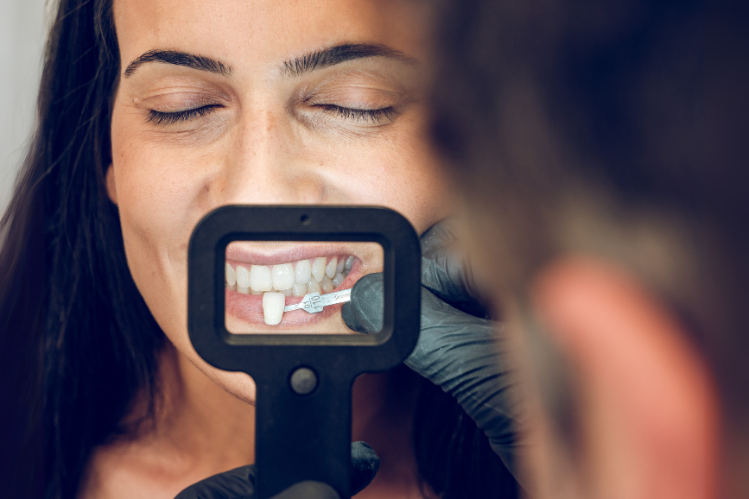
Table of Contents
- Understanding Grey Teeth and Their Causes
- Can Veneers Hide Grey Teeth?
- Veneers vs. Whitening for Stains
- Cosmetic Options for Grey Teeth
- Are Veneers for Grey Teeth the Right Option?
- Step-by-Step Veneer Procedure
- Caring for Veneers
- Fixing Discolored Teeth: Is Veneer Right for You?
- Final Takeaways: Are Veneers the Best Fix for Grey Teeth?
- FAQs
Grey teeth can be a source of self-consciousness, affecting not only your smile but also your confidence. While whitening treatments are often the go-to solution for tooth discoloration, they don’t always work on intrinsic staining, which is when discoloration occurs inside the tooth.
Those are the very few cases when veneers for grey teeth work best. This blog explores whether veneers are the right option, how they compare with other treatments, and what you should consider before making a decision.
Understanding Grey Teeth and Their Causes
Grey discoloration of teeth can occur for several reasons:
- Intrinsic Staining: This type of staining happens within the tooth structure. Common causes include genetics, childhood use of tetracycline antibiotics, or dental trauma that damages the inner layers of the tooth.
- Extrinsic Staining: These stains form on the enamel surface from external sources like coffee, tea, red wine, or smoking.
- Aging: As we age, enamel naturally thins and wears down, exposing more of the darker dentin underneath, giving teeth a greyish or dull appearance.
Because grey discoloration is often tied to intrinsic causes, traditional whitening treatments do not provide satisfactory results. This is why cosmetic dentistry solutions such as veneers are recommended.
Can Veneers Hide Grey Teeth?
Yes, veneers are highly effective in concealing grey teeth. Veneers are thin, custom-made shells crafted from porcelain or composite resin that are bonded to the front surface of teeth. Their main purpose is to mask discoloration while also enhancing shape, size, and alignment.
Dentists take extra care in selecting the shade and translucency of veneers to ensure they effectively hide darker tones while maintaining a natural appearance. This makes veneers one of the most reliable treatments for creating a bright, uniform smile.
Veneers vs. Whitening for Stains
When comparing veneers with whitening, the key difference lies in how well they address different stain types:
- Veneers: Veneers not only improve your smile but also offer full coverage, immediate results, and the ability to choose your preferred shade for a consistent, natural look.
- Teeth Whitening: Works best for mild to moderate extrinsic stains. It is even considered the safest way to whiten teeth . But it is often ineffective against deep intrinsic discoloration, especially grey tones.
For individuals with deep grey or intrinsic stains, veneers almost always outperform whitening in both results and longevity.
Cosmetic Options for Grey Teeth
Although veneers are often the top choice, other tooth discoloration solutions may be considered:
- Dental Bonding: A tooth-colored resin applied to the enamel to mask discoloration. It is cost-effective but less durable and more prone to staining than veneers.
- Dental Crowns: Cover the entire tooth and are useful when teeth are discolored and structurally compromised.
- Internal Bleaching: Used on non-vital (dead) teeth to reduce discoloration, though it is not always effective for grey stains.
While each method has its benefits and limitations, veneers consistently provide the best balance of durability, aesthetics, and effectiveness.
Are Veneers for Grey Teeth the Right Option?
Before deciding on veneers, consider several important factors:
- Oral Health: Strong enamel and healthy gums are necessary to support veneers.
- Budget: Veneers cost more than whitening but last longer and provide predictable results.
- Maintenance: Proper oral hygiene and regular dental visits are essential to maintain their quality.
- Durability: Porcelain veneers can last 10–15 years or more with proper care.
For those looking for a permanent, natural-looking solution, veneers are often the best investment.
Step-by-Step Veneer Procedure
To better understand what the treatment involves, here is a breakdown of the veneer process:
- Initial Consultation: The dentist examines your teeth, discusses your concerns, and evaluates whether veneers are the right solution.
- Treatment Planning: Impressions, scans, or photographs are taken to design your veneers. You’ll also select the ideal shade and shape for your smile.
- Tooth Preparation: A thin layer of enamel is gently removed from the front of the tooth to make space for the veneer, ensuring a natural look and comfortable fit.
- Temporary Veneers: If needed, temporary veneers are placed while your custom ones are being made.
- Veneer Placement: Once ready, the dentist carefully fits the veneers, checks the bite, and permanently bonds them with a strong adhesive.
- Final Adjustments: The dentist makes minor refinements to ensure comfort and an ideal appearance.
This process typically requires two to three visits, resulting in a dramatic and long-lasting improvement in both tooth color and overall smile aesthetics.
Caring for Veneers
Maintaining veneers is simple but essential for their longevity:
- Brush and floss daily with non-abrasive products.
- Avoid biting down on hard foods or objects such as ice, pens, or fingernails.
- Limit consumption of highly staining foods and drinks such as coffee, tea, and red wine.
- Visit your dentist regularly for checkups and professional cleanings.
With proper care, veneers can maintain their appearance for a decade or more.
Fixing Discolored Teeth: Is Veneer Right for You?
Before choosing veneers, consider the following:
- Tooth health: Veneers require healthy enamel and gums.
- Budget: Veneers are more costly than whitening but deliver longer-lasting results.
- Maintenance: Good oral hygiene and regular dental visits are necessary to preserve their appearance.
- Longevity: Porcelain veneers can last 10–15 years with proper care.
Ultimately, if you’re looking for a permanent and aesthetic solution to intrinsic grey stains, veneers for grey teeth are often the best investment in your smile.
Final Takeaways: Are Veneers the Best Fix for Grey Teeth?
Grey teeth, particularly those caused by intrinsic staining, can be difficult to correct with whitening treatments alone. Veneers offer a dependable, long-term solution that not only conceals discoloration but also improves the overall look of the smile. While other cosmetic options, such as bonding, crowns, and internal bleaching, are available, veneers consistently deliver the most natural, durable, and aesthetic results.
If you are dealing with grey tooth discoloration, consulting with a skilled cosmetic dentist is the best first step. Together, you can review your treatment options, design a customized plan, and move forward confidently toward a brighter, healthier, and more attractive smile.
FAQs
Dentists may advise against veneers if your teeth are weak, decayed, or have insufficient enamel. In such cases, other restorative options may be safer.
Teeth with severe decay, large fillings, gum disease, or excessive grinding may not be suitable for veneers, as they need a strong, healthy structure to bond properly.
The most natural veneer shades are usually within the BL1–BL4 or A1–A2 range, chosen to match your skin tone, age, and natural teeth for a realistic look.
Grey teeth can be treated with veneers, crowns, bonding, or internal bleaching, but veneers are often the most reliable cosmetic solution for intrinsic staining.
Citations:
Rojas-Rueda, S., Villalobos-Tinoco, J., Conner, C., Colvert, S., Nurrohman, H., & Jurado, C. A. (2025). Bonding protocols for lithium disilicate veneers: A narrative review and case study. Biomimetics, 10(3), 188. https://doi.org/10.3390/biomimetics10030188
Bertoni, S., Carossa, M., Favero, R., Carboncini, F., & D’arienzo, L. F. (2025). Minimally invasive resin-bonded zirconia veneers for the treatment of discolored teeth: A multidisciplinary case report by the First Committee of Junior Members of the Italian Dental Prosthesis and Oral Rehabilitation Society (SIPRO). Prosthesis, 7(1), 1. https://doi.org/10.3390/prosthesis7010001
Smith, L., Fernandez, R., & Lopez, M. (2021). Aesthetic satisfaction with veneers versus bleaching in patients with deep tooth stains. Journal of Esthetic and Restorative Dentistry, 33(4), 412–419. https://doi.org/10.1111/jerd.12567






 Australia
Australia New Zealand
New Zealand Malaysia
Malaysia English
English Portuguese
Portuguese English
English English
English English
English English
English English
English Canada
Canada